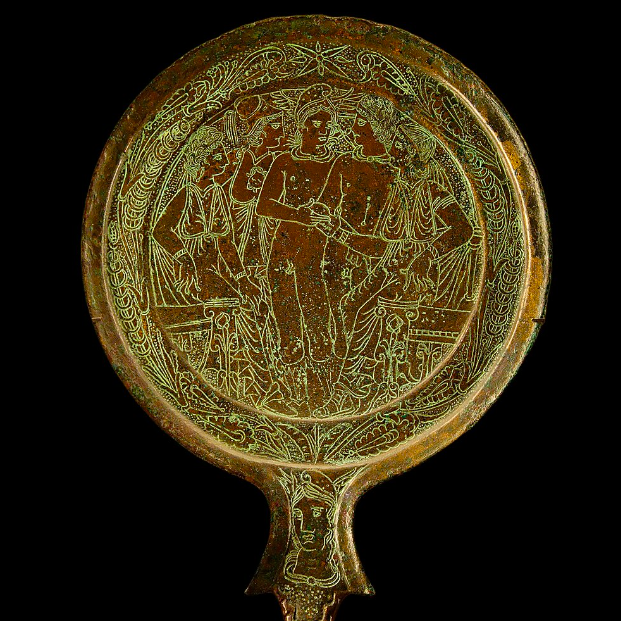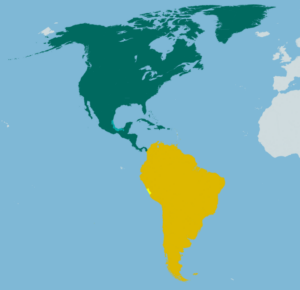Texts in Context:
The Four Corners of
the Round Earth

By Gabriel Blanchard
In tracing Western history, let us take a moment while teacher isn't looking to sneak a glance at everybody else's paper.
The Lands of Prester John
All this talk about Egypt, the Near East, and southern Europe—you’d think nothing was happening anywhere else! Were no other civilizations accomplishing anything at the time? Was this the only region that had begun to be civilized?
On the contrary, there were many budding civilizations, and they most certainly were accomplished. The present author is by no means an expert on world history; but the Persians, the Indus Valley, the Horn of Africa, and China all produced civilizations quite as sophisticated as the Mediterranean, if not more so, in the same time frame. It was only a few centuries later that much the same things started happening in Mesoamerica and the north-central Andes Mountains; and those few centuries of delay only make the achievement more impressive, considered alongside the fact that the Americas were peopled at least a few thousand years later than the Old World, and therefore had much less in the way of a “running start.” And all this is to say nothing of further civilizations that may have been smaller or more isolated but had a grandeur of their own nonetheless: the trade empires of the Gold Coast, the unstoppable cavaliers of the Mongols, the mysterious federation of Cahokia, the cities of the Swahili Coast, the amber traders and furriers of the Baltic, the Polynesian peoples who ranged from Madagascar almost to South America (the long way round!), the farming peoples of central New Guinea …
On the whole, we will only be touching briefly on most of these societies as the story proceeds. That is one reason we are making a point of doing so here.
South and Central Asia

This refers basically to the parts of Asia that lie on the side of the Himalayas nearer to Europe and Africa. Today, geopolitically, it includes the countries of Afghanistan, Bangladesh, Bhutan, India, Iran, Kazakhstan, Kyrgyzstan, Nepal, Pakistan, Sri Lanka, Tajikistan, Turkmenistan, and Uzbekistan. The northwesterly parts of this gigantic region (referred to colloquially as “the stans”) are mostly arid, and largely mountainous in the south, as the Indian Plate continues to drive into the heart of the Eurasian Plate, lifting the peaks that are called “the roof of the world.” These desert regions have been dominated by the Persians since ancient times, and, since the Medieval period, Turkic peoples have been added to the mix, both now predominantly of the Muslim faith.
Further south and east, protected from the main continental climate by its garrisons of mountains, the two seasons of the tropics (wet and dry) govern the bulk of the Indian subcontinent. The Indus Valley, created by the Indus River (which now flows through the center of Pakistan), was the site of the first beginnings of Indian civilization; it is possible that the geometric streets and grand public baths were carried east there from Sumer. For the most part, India has been a geographical term rather than a political one: except for periods when it was dominated by outside powers (such as the Mughals or the British), it has usually consisted in a patchwork of many states with a shared culture. This is less true today, since most of the region is part of the Republic of India, but Bangladesh, Nepal, Pakistan, and Sri Lanka are independent. India has a long tradition of excellent mathematics, and is the source of the number zero and the numerals we refer to as “Arabic”; it is also the land of origin of the many religions collectively called “Dharmic,” mainly Buddhism, Hinduism, Jainism, and Sikhi.
East, North, and Southeast Asia

Broadly beyond the Himalayas, we find the countries formerly spoken of as “the Orient.” Geopolitically, these are Cambodia, China, Japan, Laos, Mongolia, Myanmar, North Korea, the eastern two-thirds of Russia, South Korea, Taiwan, Thailand, and Vietnam. China has been the most dominant polity of the region, both militarily and culturally, for most of its existence; it has seesawed between periods of fragmentation and periods of unity. It has often reached similar philosophical and technological heights to the West, and indeed has outstripped the West in these things many times, notably in the inventions of the printing press, paper money, and gunpowder. One of its great masters, Confucius, is present on our Author Bank. And even the most casual glance at world history would be incomplete without some mention of the short-lived but gargantuan Mongol Empire achieved under Genghiz Khan in the thirteenth century, the single largest state ever to exist, which at its peak covered nearly the whole Asian landmass.
Presently Merlin said, “... There were tales in my day of some such: men who knew not the articles of our most holy Faith, but who worshiped God as they could and acknowledged the Law of Nature. It was rumored also that there was knowledge in those lands—an Eastern circle … I know not where—Babylon, Arabia, or Cathay.”
C. S. Lewis, That Hideous Strength
The Americas

South America is shown in gold, with the region of Norte Chico,
the earliest Andean civilization, picked out in brighter yellow;
North America is shown in dark sea-green, with the region of the
Olmecs, the earliest Mesoamerican civilization, picked out in turquoise.
The two great centers of urban civilization in the Americas were Mesoamerica and the heart of the Andes Mountains, located roughly in the south of modern Mexico and the country of Peru. By the time transatlantic contact was made in the age of Columbus, the rulers of the Aztec Empire were the masters of Mesoamerica (or at least, they were among its masters), and had built a society hardly less sophisticated than that of the Spanish. The same was true of the Inca Empire in South America, well-known for the magnificent terraced earthworks that allowed them to practice agriculture in the otherwise forbidding landscape of the Andes, the second-highest mountain range in the world. Both peoples were subjugated by the Spanish, partly thanks to the firearms the latter possessed, but far more as a result of the diseases they inadvertently brought west with them, to which the indigenous American peoples had no inherited immunity.
This latter doom fell on large fractions of the other peoples of the Americas, those who had for the most part not sought out urbanism before the sixteenth century. It is worthy of note that, in both North and South America, there are signs that this un-urbanized society was not a result of ignorance or lack of resources, but a deliberate choice on the part of the peoples in question—a rejection of the kinds of political organization that such changes in technology would have required. David Graeber and David Wengrow’s 2021 book The Dawn of Everything explores this, at some length.*
Sub-Saharan Africa, Australasia, and the Pacific

Green indicates the Sahara Desert and sub-Saharan Africa; pink indicates
regions settled by eastern Malayo-Polynesians; purple indicates Australia,
New Guinea, and Wallacea (the parts of Indonesia east of the Wallace Line);
and red indicates Polynesia proper, in the Pacific (including Hawaii).
The Sahara Desert of northern Africa is a harsh barrier, and it is small wonder that few peoples have ever crossed it; in the ancient world, only Ethiopia (which was conveniently close to Egypt and connected by the Red Sea) was familiar to the outside world. The pre-colonial history of Africa beyond the Sahara is not widely known today except to specialists; but the fact that it is not widely known leads some people to suppose there must be nothing to know. However, a region does not become the home of the single wealthiest man in the history of the earth (Mansa Musa,** a fourteenth-century ruler of Mali) by lying about doing nothing! The trades in spices, gold, and slaves throve in West Africa long before the voyages of Columbus, while in East Africa the states of the Swahili Coast (chiefly in modern Kenya and Tanzania) were advanced enough to be performing cataract surgery before the shadow of European power ever fell across them.
To the southeast of the Old World lay the Indomalayan Archipelago, from Sumatra all the way to the Solomon Islands; a third of the way through this course, we find the Wallace Line, a botanical and zoological marker dividing the native species of Asia from those of Australasia. Beyond it is the realm of marsupials and monotremes (whose most famous examples, respectively, are the kangaroo and the platypus). Mankind settled there, too: the severity of the Australian Outback did not deter the Aboriginal peoples from making it their home. Still more impressive are the Polynesians, who seem to have originated on the island of Taiwan; they were made more familiar to most of us by (of all things) the Disney films Lilo and Stitch and Moana. While not known for certain, it is possible that the Polynesians—who did certainly settle as far north as Hawai’i and as far east as Rapa Nui, or Easter Island, now a possession of Chile—were the first people from the Old World to make landfall on the Americas.
*704 pages of length, to be specific.
**It is debated whether Mansa Musa was in fact the richest man ever to live, and the question probably cannot be answered with certainty. Nonetheless, even if he only made the list of plausible entries, the point would seem to stand!
Gabriel Blanchard is CLT’s editor at large, and a proud uncle of seven nephews. He lives in Baltimore, MD.
Thank you for reading the Journal! To learn more about history, take a look at our posts on the beginning and the seemingly rather sudden end of the Bronze Age; or get your history from the horse’s mouth with figures like Herodotus, Thucydides, Livy, and Julius Cæsar.
Published on 6th May, 2024.